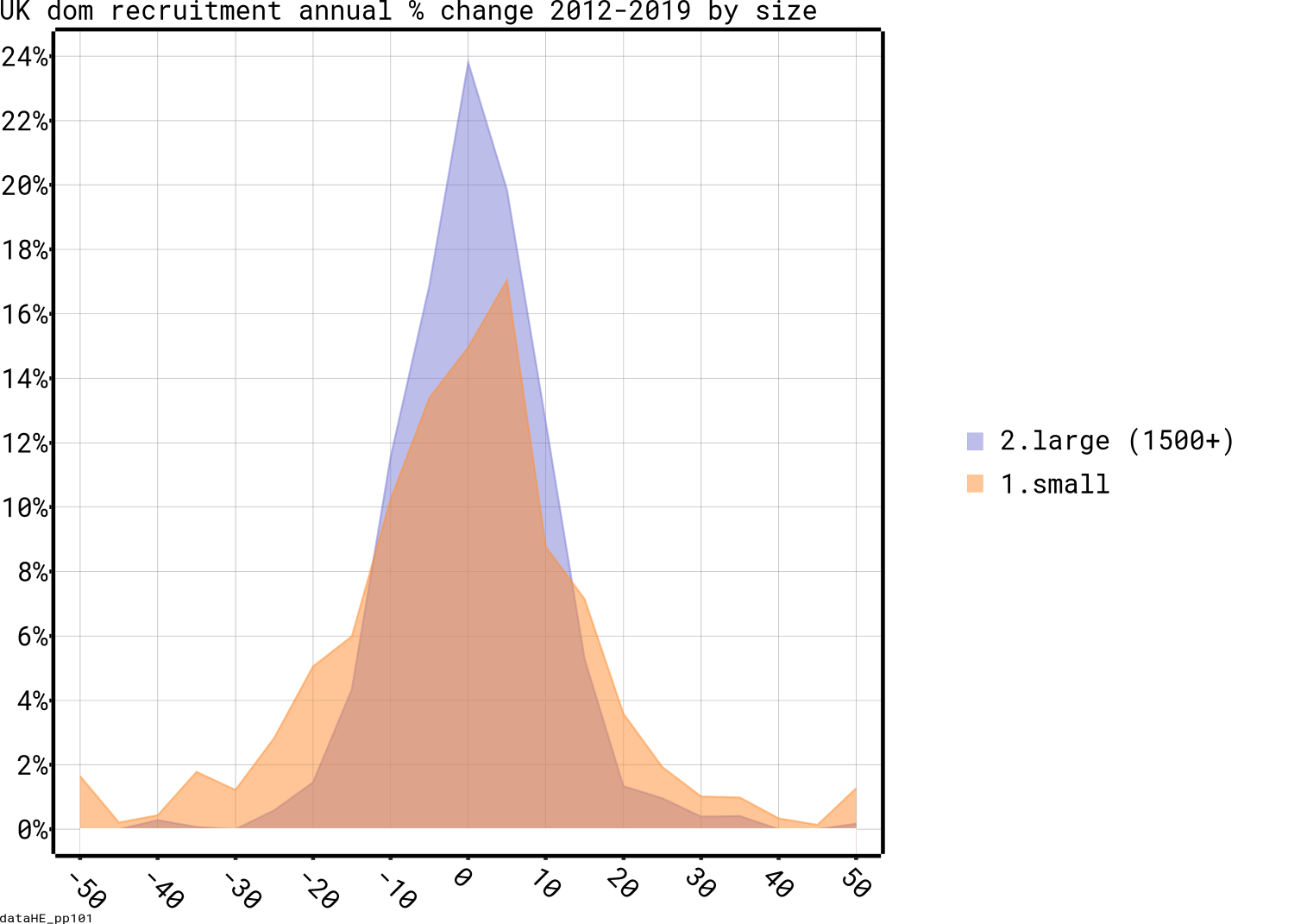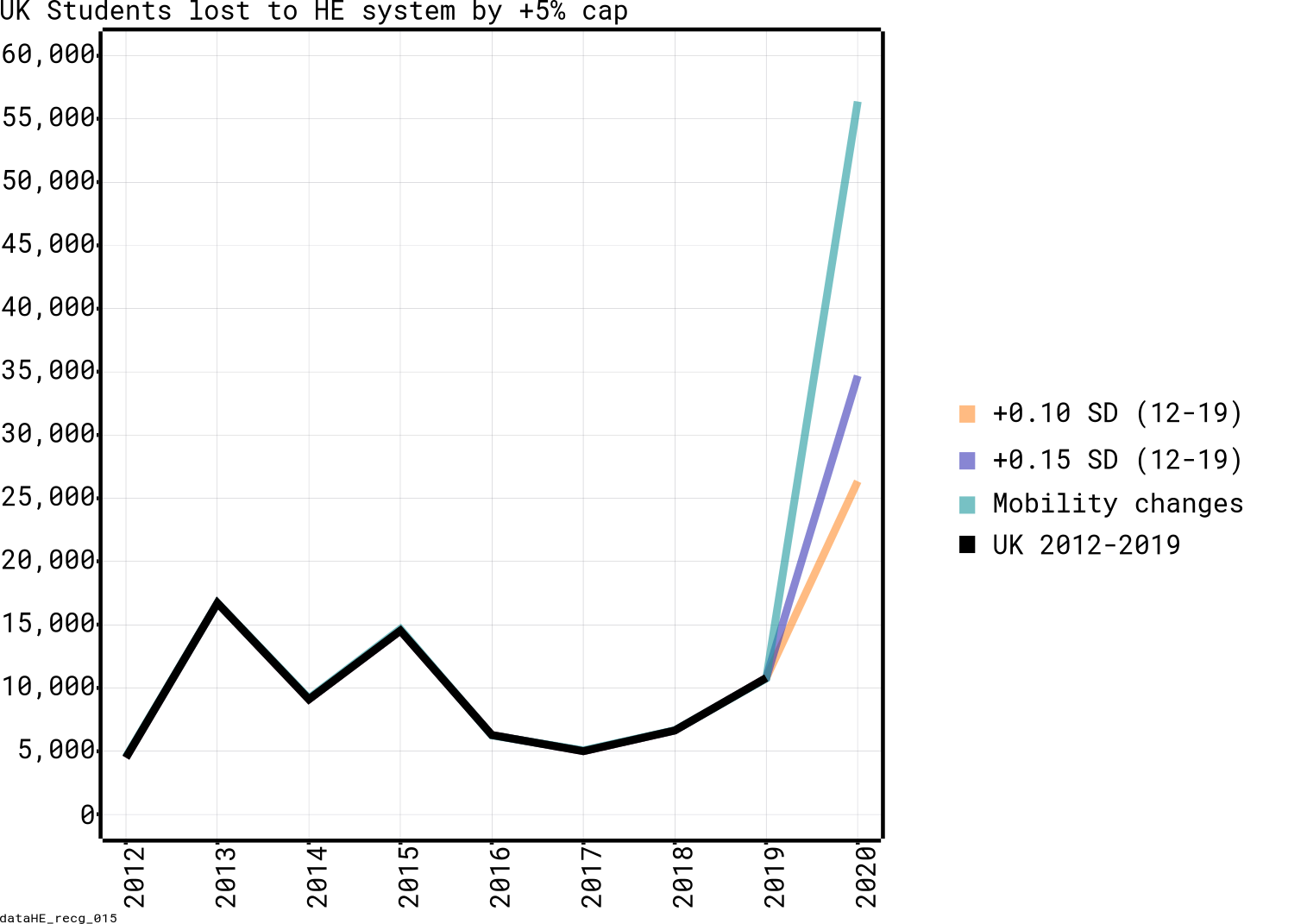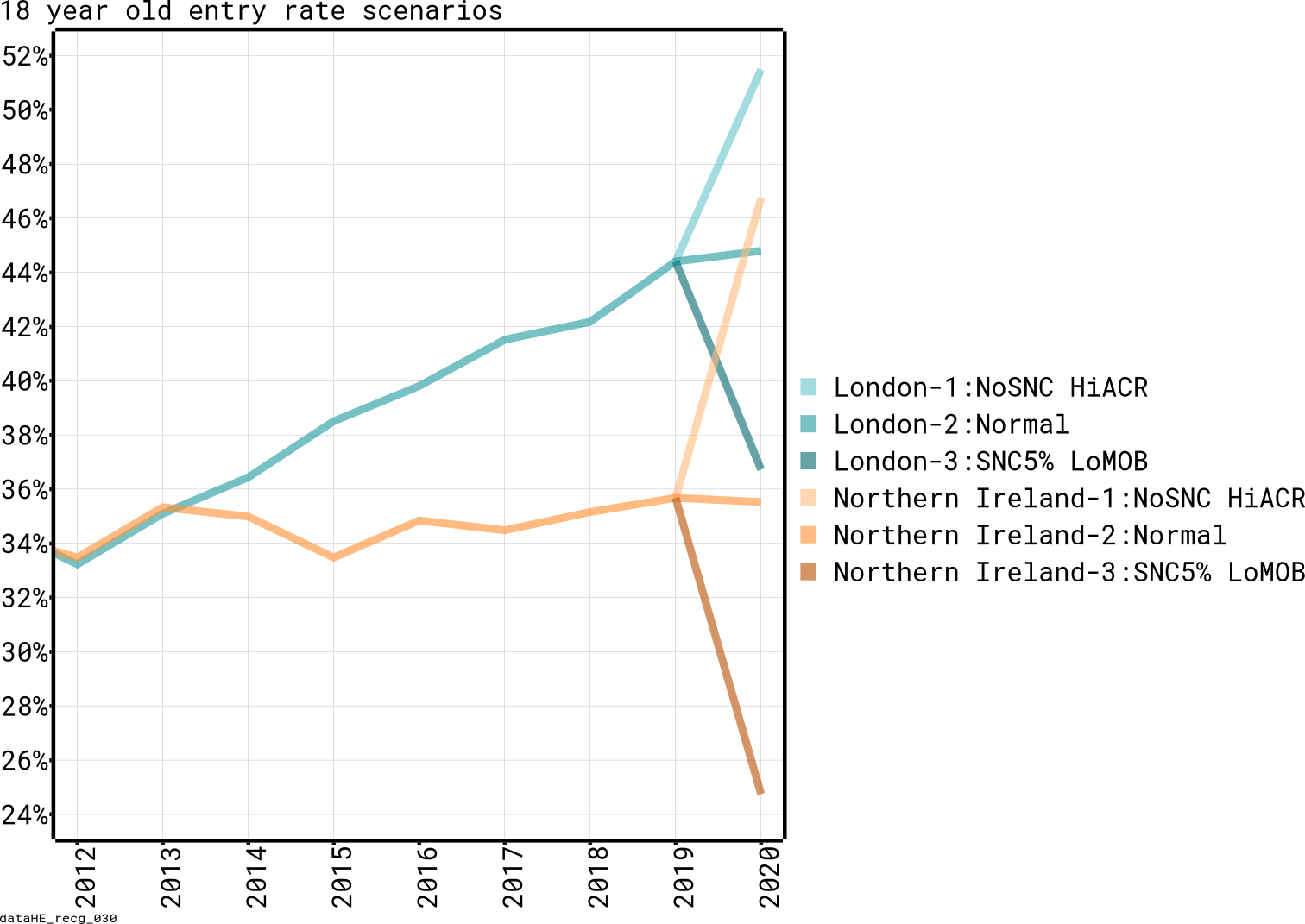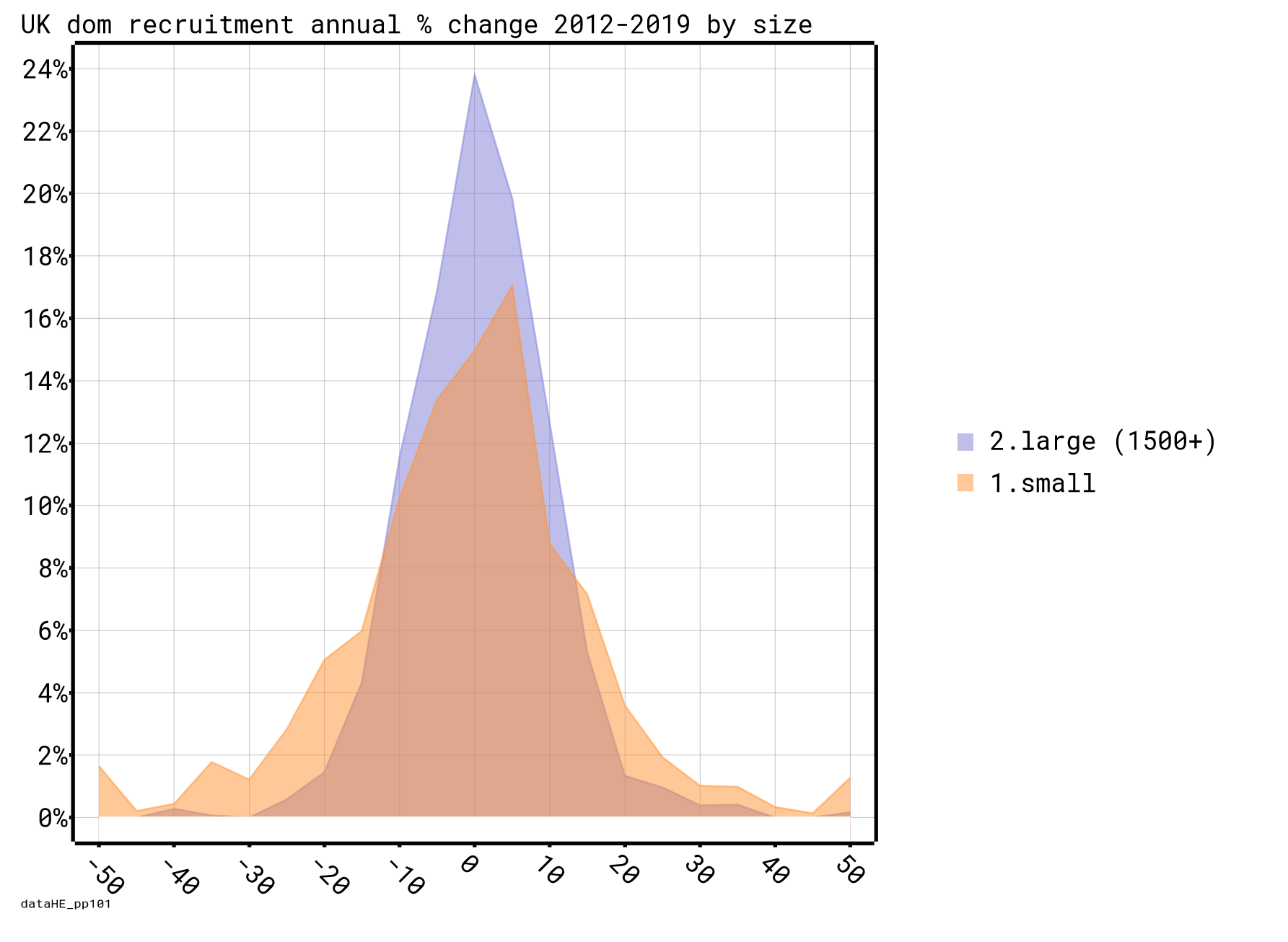[This article was originally published by wonkHE in May 2020. Student number controls were subsequently imposed in England and Wales. These were later scrapped as they were not flexible enough to accommodate the revised examination grades.]
The effects of the Covid-19 epidemic show up in data in two ways: very large negative movements in many statistical indicators, and exceptionally high uncertainty in forecasting the future.
The Office for Budget Responsibility (OBR) identified education as one of the sectors most affected sectors by Covid-19, and we’ve seen our own work with universities shifting to using data to quantify and respond to new uncertainties. Universities are having to assign material probabilities to autumn scenarios ranging from back-to-normal, through to on-campus teaching in 2020-21 simply not being possible. A failure in international student recruitment would leave extensive idle capacity. Concerns about financial viability are very real.
Student quotas
One solution to this – which the government appears to be considering for England – is student number controls. More plainly described as quotas, their suggested design will be familiar to the Office for Students staff who ran HEFCE’s 1990s era MASN (Maximum Aggregate Student Numbers) scheme. But are they the right solution for 2020?
We don’t think so. The case for quotas is that by restricting student choice they can divvy up fee income across universities in a way that can offer financial stability. But quotas make a fundamental mistake in placing little value on what students want, assuming that their personal aspirations can be redirected around the system as required. This could well lead to many students opting not to go to university, making quotas of very limited use in helping stability this cycle.
In fact, quotas can only reduce entry to higher education, and this effect grows with the level of uncertainty about how things will turn out. With higher student-university demand variability a real risk this cycle, our modelling demonstrates reductions to overall recruitment caused by quotas could be severe, including large falls in young entry rates in some scenarios. Young people entering a high quality university sector with temporary spare capacity is a cost-effective conduit for fiscal stimulus to aid recovery. But quotas turn the sector into a method of economic suppression instead.
A good solution for students and the sector needs to do three things. Give flexibility to students and universities to counter the high uncertainty. Provide financial stability to preserve important teaching capacity that is rendered temporary unviable. And to allow the sector to play its role in helping the economy recover. We have used new analysis to see how student quotas score under these headings, and what alternatives there might be.
Flexibility
The best response to uncertainty is flexibility. Imposing quotas strips both students and universities of the ability to respond to events.
It helps to be clear about the only thing that changes when you swap student choice for student quotas. Imagine a young person decides the best thing for them is to invest in themselves by studying at a particular university. And that university judges they will make an excellent student and they can utilise their teaching capacity to increase the value of that individual to society. Quotas simply mean that the Government sometimes steps in and says “No”. The student’s desire to invest in themselves is thwarted and the university is left with idle capacity. This is the only difference between the operation of a quota and student choice system.
The stability argument for quotas is that by removing choice from the student they will settle for something else. Government can then use the quotas to channel financial support in terms of the students’ fee loans across universities in whatever distribution it sees fit. Attractively, stability is seemingly secured without the need to spend any extra money. This is not unreasonable for Government to seek to do. But it would be disingenuous to cast the policy as being led by the student interest. A Government choice of quotas, over alternatives, is not driven by the student interest.
Nevertheless, you might conclude that compromising student interests to some extent was a price worth paying for sector stability. If so, how might quotas affect the 2020 cycle? One option that has been raised is to limit provider-level home and EU recruitment to no more than 5 percent above provider forecasts.
What it might look like
To give an idea of what this might mean using published data we have simplified this a bit. We are using just UK domiciled students and have taken the forecast as what providers recruited last year (since aggregate UK recruitment has been flat recently). And we are putting aside differences in number controls across the UK, and changes in EU students.
Our purpose here is to gauge the type of effect from imposing number controls on an uncertain situation.
Figure 1: Annual change in university recruitment of FT UG students

Each year changes in student pools and behaviours, together with the shifting attractiveness of universities, drive changes in recruitment at university level. All the annual changes from 2012 (excluding partial sequences, very small providers and some known data issues) give the pattern in Figure 1. Smaller providers are more variable than larger, most recruit numbers similar to the previous year, but substantial percentage increases and decreases are by no means uncommon. Over this period the standard deviation is around 10 percentage points and the distribution approximately normal, if you are interested in that type of thing.
In the past few cycles around a quarter of universities (weighted by size) grew by over 5 per cent. In a world where universities fill up once they have reached that 5 per cent limit this would have equated to around 5,000-10,000 thousand “Government says no” decisions each year.
Perhaps this level might be tolerable – it is only a couple of percent of total UK recruitment. But could student preferences change more in autumn 2020 than they have in recent years?
Changes to behaviour
It is easy to come up with candidates for why that might be so. Perhaps students will want (or be forced?) to undertake live-at-home study only. Or perhaps the opposite. Or somewhere in-between where study within the student’s home region is favoured. Could a depression-scale surge in unemployment push older students to shelter in HE, or will financial risk aversion have the opposite effect. Or is the HE demand from older students already fully satisfied, leaving the desire to shelter from economic effects playing out for young people instead? And so on for EU students, different subjects, different student backgrounds.
In each of these possibilities the effect on demand for individual universities would vary substantially, in different directions. With high uncertainty no one knows what will happen. Though it is also worth remembering that students have often surprised by their behaviours being more stable against changes in circumstances than most expect them to be. A reasonable approach we think is to imagine that the most likely UK recruitment outcome remains near to the existing trend. But the uncertainty in that outcome, and the variability in the patterns of student-university entry demand is likely to be larger, even if we do not know exactly why. It is this possibility of greater variability of demand at university level that amplifies the problem of flexibility with quotas.
To scale this, we have created a simple scenario. Not a prediction, but an illustration of how changes translate to increased variability. We imagine that young people want to go to university to avoid unemployment, pushing acceptance rates towards 100 per cent. But they do not want to move out of their region to study, though they do want to go to a similar university as they would otherwise have done. We also imagine that some, say 20 per cent, of older entrants feel they do not have the financial security to enter HE anymore and choose not to go.
Figure 2 Change in UK recruitment by university in example scenario
Figure 2 shows how the shifts in student demand in this scenario would give a much more variable pattern of university recruitment changes, particularly at the extremes. Recruitment at around a third of providers would be down by more than 10 per cent. Some would see their demand surge by 40 or 50 per cent. Around 40 per cent of providers would enjoy increases in recruitment of over 5 per cent Only, of course, they wouldn’t. They would hit their quota and must turn students away.
The stability hopes for quotas lie with these refused students obligingly changing their plans, even if it involves what they wanted to avoid (like moving across the country), and flowing – without friction – to a course and university which maybe doesn’t suit them. Perhaps they would do this, certainly some do recalibrate their aspirations when capacity limits get hit in a normal year. But many do not, and the behavioural drivers this year might be stronger than usual. It must be likely that with student choice replaced by a ‘take it or leave it’ quota arrangement, many will opt for ‘leave it’. There is always next year.
Figure 3 converts this “leave it” hypothesis to real numbers. Under the reduced mobility example, the way that quotas restrict the ability of providers to respond to the changes in demand means that around 50,000 UK students would be lost to the HE system, around 10 per cent of recruitment. If we imagine a more general increase in university-student demand variability (modelled by increasing the standard deviation of university recruitment changes by 10 and 15 percentage points respectively) we get 25,000-35,000 students lost. Student quotas will always lead to lost students, and the more variability in student-provider demand that is likely the greater the losses.
Figure 3: Lost students from a student quota and 2020 variability assumptions

Stability
If the loss of flexibility leads students to stay away from HE, then it follows the only real merit of quotas, giving financial stability to providers by forcing the students’ fee income towards under-recruiting providers, are not that secure. If students do not play along then you will still get providers in need of financial support. At the extreme, you end up with just as many universities with a stability problem than if you had simply let students go to the universities they wanted to.
A more reliable approach to securing stability is the same as what government is considering across the economy. If a large, but likely temporary, change risks destroying productive capacity then the government considers support until the temporary conditions abate.
For some transport operating companies they have done this through partially compensating for the loss of passengers their finances reasonably assumed. They have not proposed offering potential passengers a take-it-or-leave-it offer to buy tickets for journeys they don’t want make to places they do not want to go. Because it would not work.
Stability could be provided other ways. For example, the Government could fund a university-specific increase of the per-student rate of SLC payments to universities for this entry cohort. This per-student uplift would be related to the university’s reduction in fee income, whilst not entirely offsetting their revenue loss. Correctly calibrated, there should not be any perverse incentives to recruit less, whilst the higher per-student rate protects the quality of the student experience against temporary reductions in the economies of scale.
Stimulus
The third area where quotas can only do harm is the role of universities as a cost-effective channel for stimulus. We’ve found that setting university-level quotas can only reduce overall entry numbers compared to a student choice system. And the larger the shifts in student preferences, the greater the risk of erosion of entry to university. Again, just to help quantify the possible effects here we will use our reduced inter-region young mobility example from earlier, serving the same role: not a prediction but broad quantification of the damage quotas can do.
Figure 4: Entry rate pathways for different scenarios

Figure 4 shows how quotas combined with changes to student-university demand could reduce entry rates in two parts of the UK (who are more than averagely reliant on their young people being educated elsewhere). Here young entry rates would fall by 8-10 percentage points against our ‘normal’ projected entry (based on 2006-2019 trends). This equates to a lot of young people having to find something else do. It is hard to see how this would not push unemployment higher.
The upper lines in Figure 4 represent an alternative pro-stimulus trajectory. They show what would happen if young people were very keen to go to university and Governments lifted any general quotas (such as the number controls in Northern Ireland) allowing student choice to maximise the entry rate, so almost everyone who has applied to university this year gets a place. This causes entry rates jump by 6-10 percentage points. There is a young entry rate gap of up to 20 points, the fate of a fifth of young people, that could hinge on the decision of whether to have quotas or not in 2020.
The scenario example is just one constructed case, which probably would not happen in exactly that way. But the point is that variability in student-university demand could well be higher this year. And when that collides with number controls, reduced entry rates are the only possible result. When this happens, the system swaps young people co-investing with government in their human capital (and keeping universities productive), for the government supporting both students and universities to be idle. Student quotas act as economic suppression than stimulus.
It is unlikely that HM Treasury currently feel there is a shortage of people proposing new ways of spending their money. Like other forms of stimulus, sending someone to university for three years is not free. Around £20k in fees and living support a year for three years, with perhaps half of that ultimately recovered by the state through loan repayments. A net cost to government of around £10k a year. Substantial, but, for example, around a third the cost of paying employees on the furlough scheme. On top of this investing in the human capital of the mid-2020s workforce by utilising one of the best university systems in the world might well have a better than zero return. From this perspective, encouraging young people into university starts to look like one of the better fiscal stimulus options on the table.


